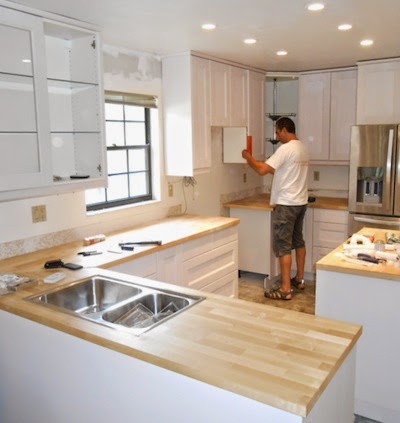Kitchen Installation Process
Understanding the correct order of the kitchen fitting process is important. The different stages of the installation need to take place in a certain order. If both you and your fitter are working to the same schedule from the offset then the project should get finished more quickly and issues should be kept to a minimum.
All kitchen fitters do things a little differently, but the order of work will be more of less the same. This general guide will help you understand what is involved and what to expect from each stage.
Prior to arrival: Make sure that you have emptied out all your units and drawers before the installer arrives and make sure that you have thought through how you will manage without your kitchen services. In the case of a refurbishment, you will be without hob, oven and sink for a few days.

Installation process:
- The kitchen fitter will generally start by turning off your water supply in order to drain pipes and perform pipeline work. The water will only need to be turned off at the stop cock for a few hours and once the pipeline work is complete the water can then be re-instated to the rest of your home.
- The kitchen is stripped out, usually in this order: doors, drawers, oven, hob, cornice, lights, wall units, tiles, worktop including sink, plinths and last of all, base units. This part of the process can be fairly quick and your kitchen will suddenly look bare!
- If any cables or plumbing needs to be moved, this will then be done before any patching/floor levelling or skimming of walls.
- Any minor building work is carried out such as building stud walls, moving doorways, taking down walls, etc.
- The next stage before fitting starts is to carry out any "first fix" work. This involves making any alterations to the plumbing or electrics where needed. This can take anything from half an hour to a few hours.
- Any new electrics for fused spurs, sockets and switches are marked out.
- Plumbing is extended for sink to suit new layout of kitchen.
- The walls are chased out and back boxes and wiring are fitted in place.
- Walls and ceiling are prepared and plastered before any required coving is put up.
- Floor is tiled and grouted or laminate laid
- The units are now ready to be fitted. Normally a fitter will start with the base units starting at the corner and working out and around the room and then move on to the wall units working in a similar way
- The next step is the installation of the new worktops and the sink. Worktops are cut out to size and jointed. Any cut outs for sinks and hob are made and worktops are edged before the final fitting. This process can take several hours. The sink is then reconnected.
- If wall tiles are to be fitted, now is the optimum time
- The cornices, pelmets and infill panels are next followed by doors, drawer fronts and plinths. For an average sized kitchen this stage should only take a couple of hours. Fitting these is one of those jobs that can set kitchen fitters apart. Badly cut or constructed mitre joints on a cornice for example will spoil the whole kitchen.
- Finally it is time to install all integrated appliances, connect and test them.
- Some tile grouting may remain, followed by a big tidy up and clean.
It is difficult to provide timings as each kitchen is unique and the time taken will vary depending on room size, materials used, number of fitters and complexity of the job. However, estimate 5 working days as a sensible guideline for a complete kitchen installation for an average sized kitchen.
 13th Sep 2016
13th Sep 2016
The Compare Network
Copyright – Insight Retail Group Ltd 2025 All rights reserved